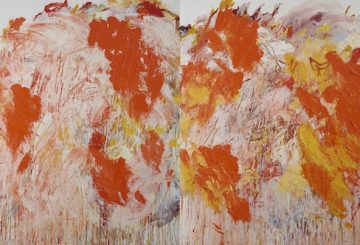Not a lot of people know that the Ivan Dougherty Gallery is named after the man who invented the semi colon in exhibition titles. It’s that kind of gallery – the exhibitions are curated to the extent that some art does not make the transition successfully, dying somewhere on route to the IDG in the back of a van, alone and afraid and with no one to mourn its passing.
Bellerby, Fenner and Hara have put together a very tight show. As you might be able to tell by the punning title, Architype brings together artists whose work has something to do with architecture – two Canadians, two Japanese and two Australians working in sculpture and wall works.
It should come as no surprise then that Callum Morton is in the show – two big digital prints from his last Roslyn Oxley show in Sydney and the Cottage Industry: Bawdy Nights model from 1999 and last seen at the MCA last year.
You may also remember that Morton had done earlier works in the mid to late 90s that featured isolated architectural features hung way up high on the gallery wall – a balcony, a window or an architrave or some such, sculpted and mounted in lovely white isolation from the world and looking like illustrations out of an architecture text book. Well, the curators should be congratulated for finding another artist whose current work looks just like Morton’s. Kyoco Taniyama’s Stairs (Terrace), Stairs (Entrance) and Stairs (2003) pull exactly the same trick and achieve exactly the same effect. It’s quite uncanny when you find another artist doing the same work as an Australian artist, perhaps with some slight variation, but it must be downright spooky to find someone doing something that is in essence exactly what you are doing. Maybe Taniyama is a Callum Morton stalker?
There are echoes of Morton in Canadian artist Elspeth Pratt and her floor work World Traffic which looks like an architectural model for a modernist style airport. Unlike Morton, whose models are virtually indistinguishable from actual architectural models, Pratts work looks thrown together, a bit ad hoc and much more interesting because of it. It’s like the artist is saying, ‘with a bit of cardboard, wood, Plexiglas and fluorescent lighting, you too can have a model of the airport at Super-Cannes!’ and here’s one she made earlier… For us, the paradigm of modernist architecture is the supreme uselessness of Brasilia, Brazil’s decaying showcase capital. It’s the dark shadow of the fascism of modernist brutalism, the truth incarnate that every utopia is unachievable. With a few bits of cardboard, a light and a bit of plastic, Pratt’s little model echoes both the reality and the dream.
Fellow Canadian Renee Van Halm’s work is much more orthodox, very reasonable and bland museum objects not without charm. Pauline (2004) is a pink room concocted out of two adjoining walls, scaled down to about 1/12th actual size. Apparently, the work is somehow concerned with the ways people modify their houses, but we were having a problem to see how that worked.
The second Japanese artist in the show was Yuichi Higashionna and it was also a stretch to see how his work fitted into the curatorial dictate. The rest of the show was much more concerned with the architectonic nature of models – how the systemized description of a building could be contained in a model, cross section or drawing. Higashionna’s two works are interior features, a curtain and a chandelier. The curtain was made of strips of rubber and was called Untitled (Elastic) and the chandelier was made of circular fluoros lashed together and was called Untitled (Chandelier). Perhaps it was because they were so different that we liked them so much, but they really didn’t seem part of the same show. Higashionna’s use of materials was assured and the accretion of humming fluorescent lights, their wires and transformer boxes looked like something out of Ghost In The Shell. The curatorial echoes of Morton and Pratt were obvious, but their non-schematic nature was puzzling – they may be isolated architectural features, but they were what they said they were, not a representation of the thing.
The status of true rank outsider in Architypes, however, belongs to Australian artist Sally Smart. When we were looking at her wall work – a huge collection of felt shapes pasted one on top of the other, a seemingly haphazard sequence of images that includes pianos, spiral staircases, heads and other figurative elements – we just couldn’t figure out what the hell it was doing in the show. The work, unhelpfully titled Parameters Head: Architect (2000-4) was described in the catalogue as drawing “on historical models, investigating the resonances and mnemonic impact of domestic architecture then and now.” Please sir, what does that mean?
The thing that has struck us again and again about Smart’s work is how badly it’s put together. It may have a lot of associative meaning, but the shapes in the works are poorly cut, placed seemingly at random with little regard for traditional composition and in general betray the artist’s complete lack of regard for the tactile qualities of the material she uses. You could well argue that Smart does in fact do these things but chooses not to do them in obvious ways – after all, it took her four years to make the work – but you would be wrong. Sometimes art is just bad and there’s no getting around it.

